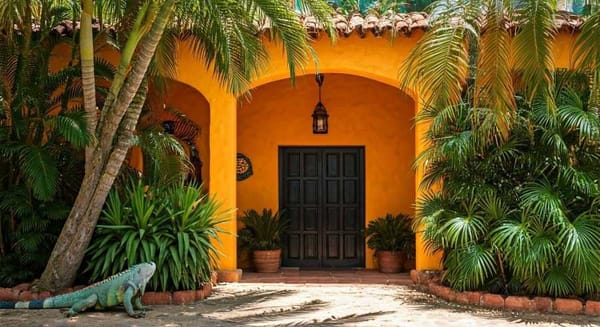What is the importance of the codices and which ones are currently in existence?
As the bearers of one of the most amazing writing systems in Mesoamerica, codices were the means used to record primarily calendrical and ritual matters. Such documents represent one of the roots of Mexican indigenous identity.

The codices were a means of witnessing the present and saving the future of history. All this rested on the exquisite symbol of line and color. On this sheet, of unparalleled beauty, rested chronology, astronomical science, mythology, the genealogy of sovereigns, and the glories of the military, with the consequent tribute of the subjected peoples. These books sought to ensure the religious thought of the priests and to affirm the conscience of the power of the rulers.
But for the Spaniards who arrived and settled in these lands these represented many other things, all of which meant a threat to their purposes of controlling the cultured, organized, and well-integrated Mesoamerican society. Moreover, they felt the urgent need to impose a religion, as they considered the one embodied in the paintings of the Mexicans to be abominable.
The difference between a people oppressed by military force and one truly conquered lies in the fact that the latter is one on which not only a new way of living, that of its masters, has been imposed, but also a new way of thinking, of seeing the world. During the Second World War, for example, France was occupied for several years by the German army. However, the French, whose lives were brutally altered during that time, did not change their way of thinking, their language, their religion...
The Spanish conquest in America, on the other hand, went much further than destroying, by the power of arms, the nations that existed here, it attacked, by all means, their culture, trying to erase it and replace it with its own. Although today the peoples of what was once Mesoamerica are Catholic, not worshippers of the ancient gods, and speak Spanish, no longer Nahuatl or Mayan or Zapotec, we cannot say, five hundred years later, that this purpose was completely fulfilled. The children of the racial and cultural mestizaje of indigenous and Spaniards live a new culture, different from the ancestral one, but also the one brought by the conquerors.
The Mesoamerican codices were systematically destroyed by the Spaniards. In this process of destruction, two episodes stand out that have deprived us of irreplaceable information about the past. Fray Juan de Zumárraga, who in 1547 was named the first archbishop of Mexico City, was the introducer of the printing press in America. With a clear vision, he understood the need to produce books in New Spain. And curiously, at the same time, he was one of the greatest destroyers of the books that already existed here, the codices, and he had many of them burned, including all the archives of the kingdom of Texcoco.
In 1562 Fray Diego de Landa, Bishop of Yucatán, organized an inquisitorial auto de fe in the town of Maní, in which numerous indigenous priests were executed and a multitude of Maya codices was burned. Today we only know of 21 pre-Hispanic Mesoamerican codices, but there are others, made in the early years of the conquest, which already show the combination of indigenous and Spanish materials and elements. The specialists who study the codices group them, according to the region of origin, into three large groups: the codices of the central region, the Mixtec codices, and the Maya codices.
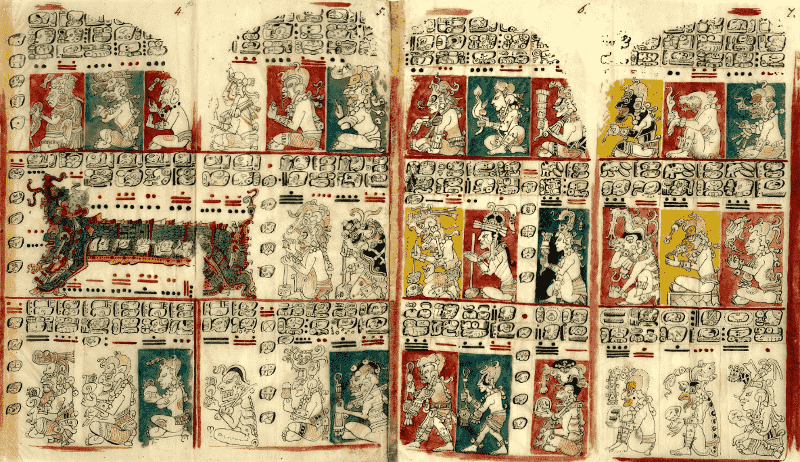
Codices of the central region
Pilgrimage strip or Codex Boturimi
Also known as Codex Boturimi or Strip of the Museum (Tira de la peregrinación in Spanish). It is a pre-Hispanic codex painted on amate paper. It forms a long strip 19.8 centimeters high by 5.39 meters long, which tells the story, probably mythical, of the pilgrimage of the Aztecs from their departure from the legendary Aztlan, in search of the sign that according to the prophecy would indicate where they should found their city, the island in the middle of the lake, on which, on a cactus, an eagle that devoured a snake should perch. This historical and geographical codex is today in the Library of the National Museum of Anthropology in Mexico City.
Tribute registration
This very important Nahuatl document, which presents the territorial extension and economic power of Mexico-Tenochtitlan and its allies, is painted on 28 pages of amate paper. It is a list of the towns of the Aztec empire that paid tribute to Mexico City, and it indicates the types of products and the amounts of tribute paid. It probably served as a model for the pre-Hispanic Codex Mendoza, of which we will speak a little later. It is also in the Library of the National Museum of Anthropology in Mexico City.
Bourbon Codex
Bourbon Codex is a calendrical-religious codex, which represents a tonalámatl, that is to say, a ritual calendar of 260 days. At the same time, it shows a cycle that represents 52 years and a series of festivals of the "veintenas", which were something like the "months" of the Mexican-American calendar. It constitutes one of the main testimonies of how the pre-Hispanic gods were represented. The codex was for many years in the Library of El Escorial, in Spain, but around 1823 it appeared in France, in the possession of the Library of the Bourbon Palace; that is why it is known by that name. It is a Nahuatl codex, made of amate paper, containing 36 sheets measuring approximately 39 by 39 centimeters.
Codex Borgia
Codex Borgia is a pre-Hispanic codex, with a calendrical, astronomical, and ritual theme. It was the property of Cardinal Stefano Borgia, after whom it is named. It is now in the Vatican Library. It comes from the Cholulteca region, the so-called Mixtequilla, which is located between Puebla and Tlaxcala. It is a strip of deerskin measuring 10.34 meters long, divided into 29 folded sheets of 27 by 26 centimeters.
Vatican Codex
Vatican Codex bears this name because it is in the Vatican Library. It seems to have been painted at the beginning of the XVI century and is probably pre-Hispanic and also comes from the Cholulteca region. It is a sheet of deerskin measuring 91 by 51 centimeters. It can be considered a religious codex, since it presents the gods of the south and the cihuateteo, the women who died in their first birth and who, in the religious conception of the Nahua, were comparable to warriors who had died for not allowing a captive to escape. For this reason, they were deified and it was thought that they accompanied the sun on part of its journey.
Codex Cospi or Bologna codex
Codex Cospi is also known as the Bologna codex because it has been deposited in a library in that city since the mid-17th century. This pre-Hispanic codex, calendrical-astronomical, also comes from the Cholulteca region. It is a strip of deerskin 3.70 meters long, divided into 24 sections of 18 by 18 centimeters.
Codex Féjérváry-Mayer
Codex Féjérváry-Mayer takes its name from the two owners it had in the 18th and 19th centuries, the Hungarian Gabriel Féjérváry and, around 1819, Joseph Mayer, who donated it to the city of Liverpool, England, where it is now in a museum. This mythological codex, with the traditional pictographic representation, is made on a leather strip 3.85 meters long, divided into 23 sections of 17.5 by 17.5 centimeters. It comes like many others from the Cholulteca region.
Codex Laud
Codex Laud is probably a pre-Hispanic Nahuatl codex from the Cholulteca or Mixtequilla region. It takes its name from the Archbishop of Canterbury, William Laud, who donated it to Oxford University. It is a strip of deerskin 4 meters long, divided into 24 sections of 16 by 16 centimeters, with 46 pieces of paintings and two oil paintings. It has a calendrical, astronomical, and religious theme.
Codex Tonalámatl or Codex Aubin
Codex Tonalámatl, also known as Codex Aubin on indigenous paper, is of 20 sheets of 27 by 24 centimeters. It was taken out of Mexico in 1840 by a famous French collector from whom it takes its name, Geopil Aubin. In 1836 Mexico had already passed a law according to which foreigners, in order to take out of the country any type of goods, had to obtain the authorization of the Congress. Everything seems to indicate that Aubin, without complying with this procedure, took this and other important documents out of the country. Therefore, when a number of years ago a Mexican citizen, José Luis Castañeda del Valle, managed to take the codex out of the National Library in Paris (where it was located) and bring it back to Mexico to hand it over to the authorities, he was not considered guilty of the theft; on the contrary, for many Mexicans, he suddenly became a hero.
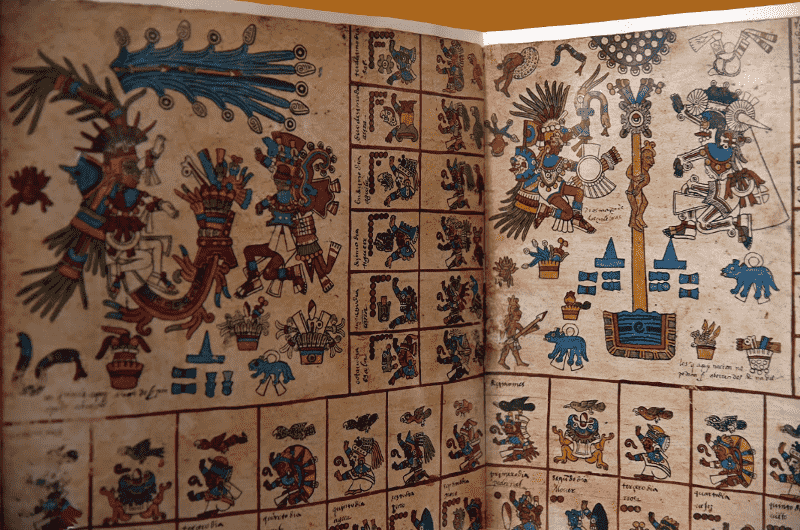
Mixtec codices
Codex Nuttall or Zouche
Codex Nuttall is also known as Zouche. This pre-Hispanic codex is a strip of deerskin 11.22 meters long, containing 48 pages of 22.5 by 18.8 centimeters. It bears the name of its first researcher, Zelia Nuttall, and its contents are historical and genealogical in nature. It shows a series of important details about the religious life of pre-Hispanic Mexico, the intervention of gods and mythical figures in the destinies of men, as well as their relationship with their ancestors. There are drawings that explain how they came out of the interior of the earth and the trees. In this codex are captured the conquests of the great Mixtec chiefs, among which stands out the figure of a prince known as Jaguar Claw Deer. It also tells us about the festivities and even a calendar reform that took place at the end of the 10th century. This document is in the University of Oxford.
Vienna Codex or Mexican I
Vienna Codex also called Vindo-bonensis or Mexican I. This historical-mythological codex, written in the Mixtec system, is in the National Library of Vienna, from which it takes its name. It was part of the treasure sent by Hernán Cortés to the Spanish emperor Charles V. It is a strip of deerskin 13.55 meters long, divided into 52 sheets of 22 by 25.8 centimeters.
Codex Colombino
Codex Colombino is a deerskin strip of 6 80 meters, divided into 24 sheets of 18 by 25 5 centimeters. It has a historical and genealogical theme, painted in the region of Tuxtepec, Oaxaca. Although Christopher Columbus had nothing to do with its discovery, it bears his name. It is currently in the library of the National Museum of Anthropology in Mexico City.
Codex Bodley
Codex Bodley is so named because since 1603 it has been housed in the Bodleian Library at Oxford University. It is a historical and genealogical document painted on a strip of deerskin 11.60 meters long, with 40 pages measuring 26.5 by 28.5 centimeters. The codex presents an unfinished painting since its completion was violently interrupted by the conquest.
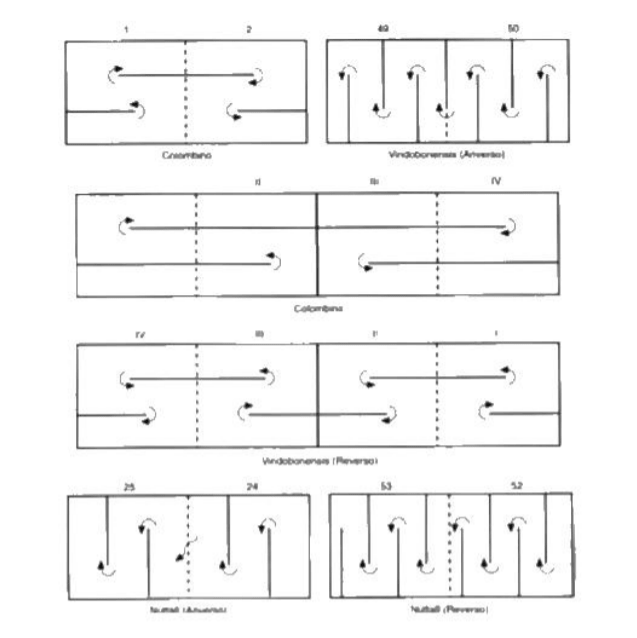
Mayan codices
Dresden Codex
The Dresden Codex has been in the Royal Library of Dresden, Germany, since 1739. It is a 3.5-meter long strip of indigenous coated paper, folded into 39 sheets written on both sides, with figures and text in Maya hieroglyphic script. The codex is calendrical, astronomical and ritual, and has represented an invaluable document for the many researchers around the world who are succeeding, at an accelerated pace, in deciphering the Maya writing.
Codex Perestanus or Paris Codex
Codex Perestano is located in the National Library of Paris. It is a strip of indigenous paper 1.45 meters long, folded in 11 sheets of 20 by 12 centimeters. It contains a wheel of the Mayan zodiac (katun) and the enthronement of the deities. It is one of the documents that have served to know and understand the complex Mayan system of time measurement.
Codex Trocortesianus or Madrid Codex
Codex Trocortesianus is located in the National Library in Madrid. It was discovered in Spain between 1860 and 1879 by Brasseur de Bourbourg. It is called Trocortesian because it is composed of two sections, the first was owned by someone named Juan de Tro, and the second is named after Hernán Cortés. It is a strip of indigenous paper 7.15 meters long, folded in 56 sheets of 24 by 13 centimeters. Its content is religious, ritual, and ceremonial. It also includes information on hunting, agriculture, beekeeping, and weaving.
Before discussing two important codices painted after the conquest, it should be noted that different specialists interpret the codices in different ways. Thus, what for one may be an exclusively astronomical and mythological document, for another may well be an agricultural calendar. In reality, what usually happens is that the same codex contains very rich and diverse information, and different things can be found in it according to the specific interests of each researcher.
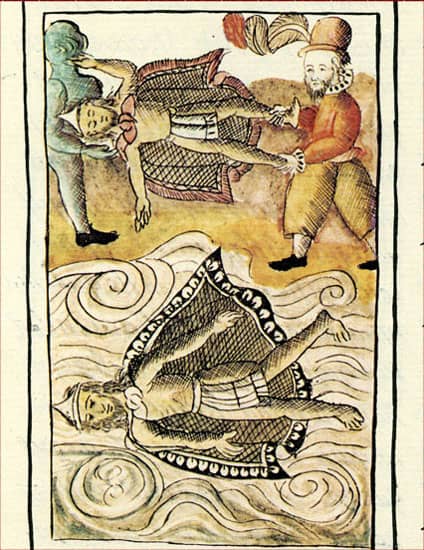
Post-Hispanic codices
Post-Hispanic codices
Florentine Codex
Fray Bernardino de Sahagún arrived in Mexico, almost certainly in 1529, in a ship in which 21 indigenous people of the highest Mexican nobility, who had been taken to Spain by Hernán Cortés, were also traveling. One of them was none other than the son of Moctezuma Xocoyotzin, the emperor overthrown by the Spanish conquistadors. Perhaps this first contact awakened Sahagún's enormous interest in all things indigenous, which would lead him to write and have written important works documenting the past - then so fresh and recent - of pre-Hispanic splendor.
Perhaps the most important work he left us is the so-called Florentine Codex, in Spanish and Nahuatl (written in Latin characters), written by a group of indigenous people known as "Sahagun's informants". They were generally indigenous nobles versed in the knowledge of their own culture. The codex is made of European paper and painted with a technique that is more Spanish than indigenous. It is divided into twelve books in which the gods, festivals, customs, and natural resources of this land are analyzed.
Codex Mendoza
Codex Mendoza, executed shortly after the conquest, has 72 sheets and was made on European paper. This document contains the list of all the products that the regions conquered by the Aztec empire paid as tribute to Mexico-Tenochtitlan, and how these tributes were administered in the royal stores. It was elaborated because the first viceroy of New Spain, Antonio de Mendoza, gave the paper to a group of indigenous nobles, with the assignment to illustrate in it everything that could be useful for the Spanish monarch, Charles V, to know more closely the wealth of the world that had just been incorporated to his empire.
The indigenous people, no doubt familiar with the pre-Hispanic style of illustrating the tributes received and the domains from which they came, as they appear, for example, in the Tribute Register, made a codex very similar to that one, but with the addition of inscriptions in Spanish and Nahuatl written in the Latin alphabet. This work resulted in the Codex Mordecaius, which for a long time passed from hand to hand - it was even the booty of pirates - until it ended up in the Bodleian Library of the University of Oxford, where it is still to be found.
The codex shows the large quantities of agricultural tributes that arrived in the Aztec capital, especially corn, beans, chia, chili peppers, salt, but also items that were not produced in central Mexico, such as cocoa, cotton, exotic bird feathers, cochineal, which was used to make dyes, and many more, among which paper occupied an important place.
Source: Los señores del papel by Boris Berenzon




